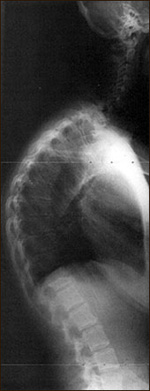Kyphosis is the term used to describe an abnormal outward curvature of the spine. If severe, the condition can contribute to a “hunchback” appearance, and may require spine surgery for treatment.
What Is Kyphosis?
A certain degree of curvature is normal in the human spine. In fact, the gentle inward and outward curves of the neck, upper back and lower back are necessary for keeping the body properly balanced and aligned over the pelvis. Kyphotic curves are the outward curves; those that curve inward are called lordotic.
The term kyphosis is generally used to describe an excessive outward curve, or rounding, of the spine. Again, some kyphosis is normal – typically 20-50 degrees; curves greater than 50 degrees are considered abnormal. A spine with kyphosis can look normal, or it can develop a “humpback” appearance.
Mild kyphosis may cause few problems; however, severe kyphotic curvature can affect the lungs, nerves and other tissues and organs, causing pain and other problems.
 There are several types of kyphosis, and the condition can be found in children, adolescents and adults.
There are several types of kyphosis, and the condition can be found in children, adolescents and adults.
Postural kyphosis, or postural roundback, is the most common form of kyphosis and is often attributed to poor posture. Habitually “slouching” can stretch spinal ligaments and contribute to abnormal vertebral formation. The condition usually appears during adolescence, and is more common in girls than boys. Postural kyphosis is marked by a smooth, flexible curve that is not typically associated with pain, and usually doesn’t lead to problems later in life.
Scheueremann’s kyphosis most commonly develops in teenage boys. It is characterized by a short, sharp curvature in the middle part of the upper spine, and may be associated with aching back pain. This type of kyphosis tends to be rigid on clinical examination. A mild degree of scoliosis is common in adolescents with Scheueremann’s kyphosis.
Congenital kyphosis can be caused by a malformation of the spinal column during fetal development. Several vertebrae may be fused together or the bones may not form properly. This type of kyphosis may worsen as the child grows.

Disorders that can contribute to kyphosis in adults include:
- Osteoporosis, which can lead to vertebral compression fractures of the spine;
- Degenerative spinal conditions, such as arthritis
- Infections
- Tumors
- Spina bifida
- Paralytic diseases such as cerebral palsy and polio, which can stiffen the bones of the spine.
- Connective tissue disorders, such as Marfan syndrome
- Trauma
What Are The Symptoms Of Kyphosis?
The symptoms of kyphosis may include:
- Slouching posture or hunchback
- Mild back pain
- Spinal stiffness or tenderness
- Fatigue
In mild cases, kyphosis may produce no noticeable signs or symptoms.
How Is Kyphosis Diagnosed?
To determine whether kyphosis is present, your provider will conduct a thorough examination of your back to check for an abnormal curvature. If kyphosis is suspected, your provider will do a spinal x-ray to determine the severity of the curve and to check for any deformity in the vertebrae. If your provider suspects a tumor or infection, he or she may request an MRI (magnetic resonance imaging) of your spine.
Your provider will also check to see if you’re experiencing any neurological changes (weakness, paralysis, or impaired sensation) below the level of the curve. To determine whether the curve is affecting your breathing, your provider also may conduct tests to check your pulmonary function.
How Is Kyphosis Treated?

Treatment decisions regarding kyphosis are based upon the patient’s age and physical condition, the cause of the curvature, the degree of deformity, the risk of progression and the severity of symptoms associated with the kyphosis. Treatment options for kyphosis include observation, exercise/physical therapy, bracing or surgery.
Surgical treatment is reserved for severe curves and in instances where non-surgical therapies have failed to provide sufficient symptom relief over a reasonable length of time. Surgical treatment consists of both a correction of the deformity using spinal instrumentation and fusion of the involved portion of the spine to prevent progression.
The decision to treat kyphosis surgically requires careful consideration between you and your provider. Factors to be considered are your specific condition and overall physical health. Discuss your condition thoroughly with your provider, and rely on his or her judgment regarding which treatment option is most appropriate.

